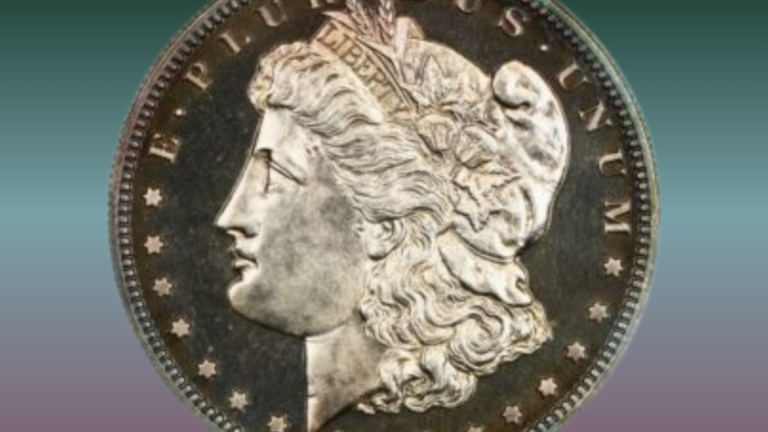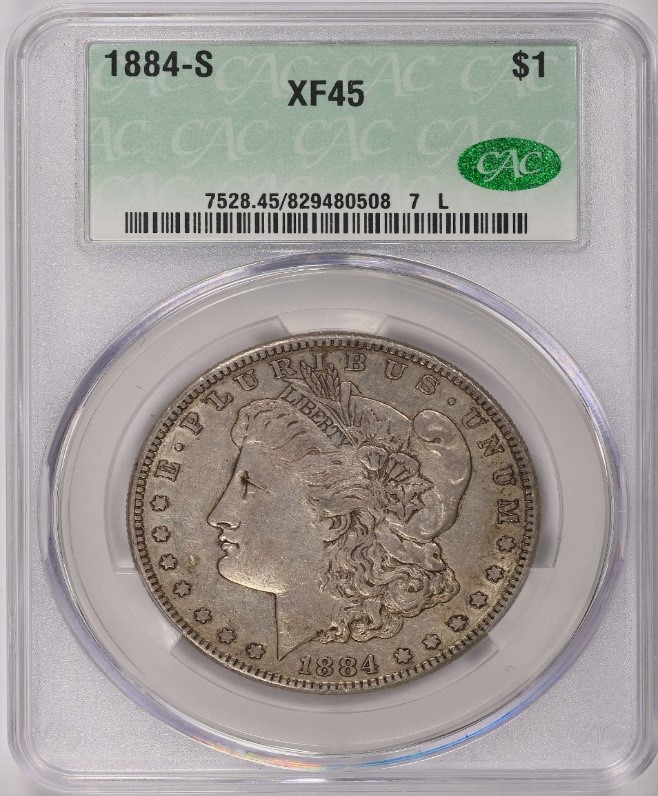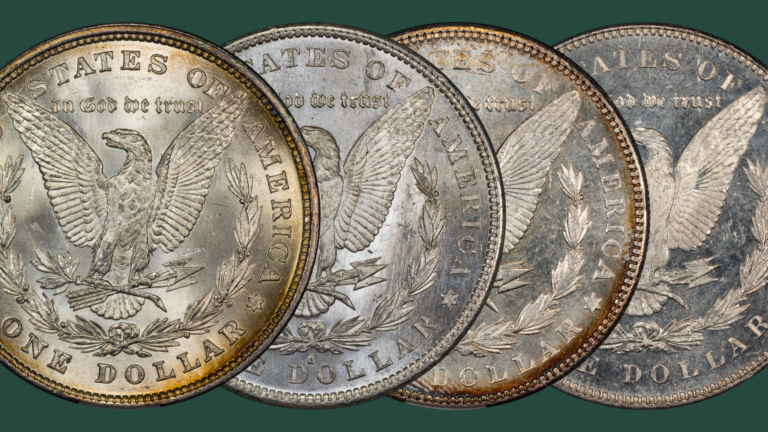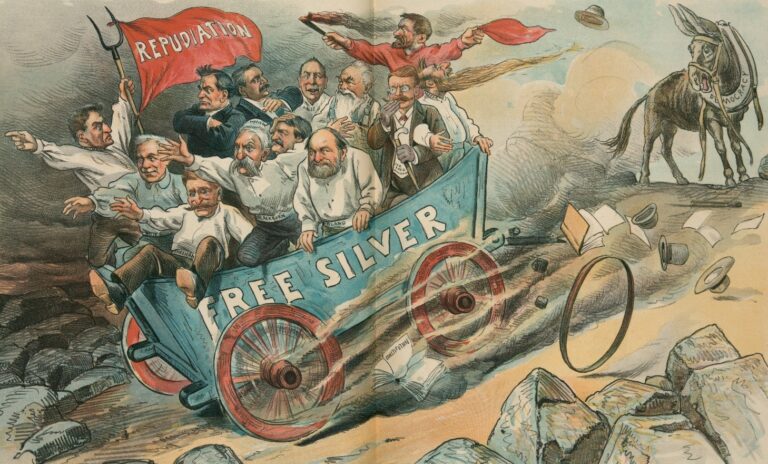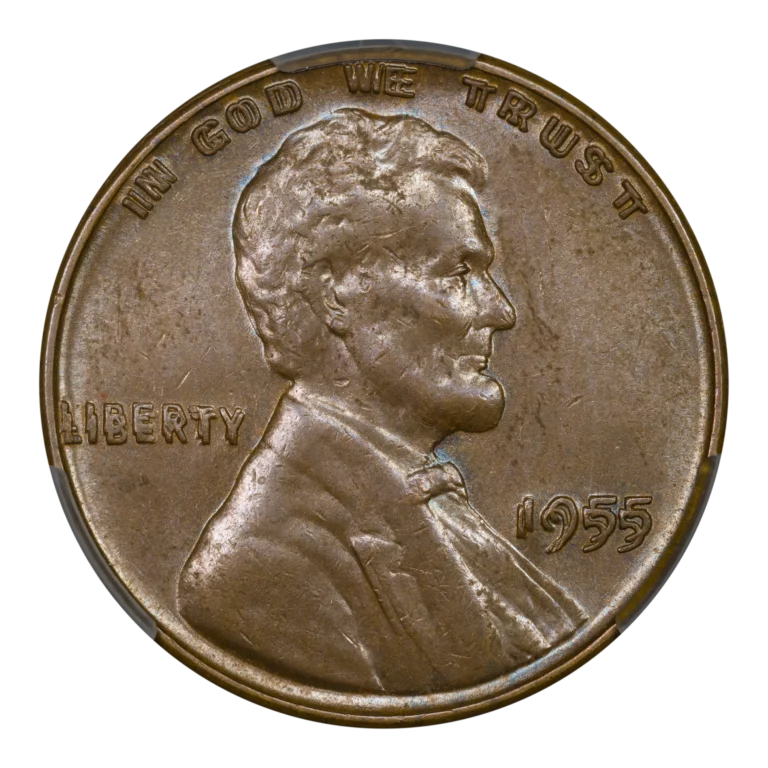by Greg Reynolds
Gem Uncirculated (MS-65 and higher grade) half dollars dating from around 1808 to the early 1860s are often neat and exciting. For many years, I have been thrilled to examine them. With the probable exception of the 1839 ‘No Drapery’ (Type #6), gem quality representatives of all design types of half dollars that began to be minted after 1806 are likely to be available in the near future for fair collector prices.
A complete type set of halves, mostly of gem quality, dating all the way back to the 1790s is a different matter. For a very affluent and very serious collector, it is probably realistic to plan to acquire gem quality representatives of five or six of the nine design types of U.S. half dollars that were adopted for production before the U.S. Civil War (1861-65), and Choice Uncirculated (MS-63 to -64 grade) representatives of the others. Considerable patience may be required.
While all the distinctions among design types may seem confusing at first, the design types will become clear to collectors who spend time viewing coins and pictures of coins. It is easy to gradually become very familiar with all the design types without thinking too much about them. Much such learning occurs subconsciously.
It may help to remember that half dollars of the seventh type (With Drapery, No Arrows, No Motto) were minted from the middle of 1839 until some point early in 1853. This seventh design type was reinstated in 1856 and lasted until 1866. The half dollars of the seventh type that were minted from 1856 to 1866, however, were specified to be of a lower weight than the half dollars of this same (With Drapery, No Arrows, No Motto) design type that were minted from 1839 to 1853. The silver content of half dollars was reduced in 1853.
Type #9 – Liberty Seated, No Motto, With Arrows, No Rays (1854-55)
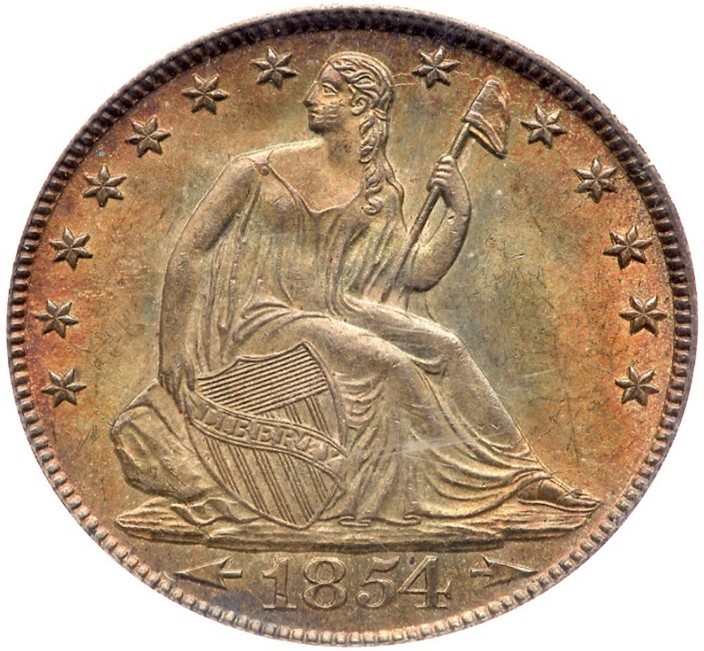
Like 1873 and 1874 halves, 1854 and 1855 halves were minted with arrows on the obverse (front of the coin). The 1873-74 halves, however, exhibit the motto, ‘In God We Trust,’ on the reverse (back). This motto was added in 1866, so 1854 and 1855 ‘With Arrows’ halves do not have this motto.
In 1853, the weight standard for half dimes, dimes, quarters and half dollars was reduced. Both arrows and rays appear on half dollars and quarters dated 1853. The rays were then omitted from the design.
By 1856, U.S. citizens were aware of the reduction in the weight standard and there was thus no longer a strong reason for arrows to appear on U.S. silver coins. The main reason for using ‘arrows’ to announce and emphasize the new weight standard was to encourage people to spend silver coins rather than hoard or trade them.
While all the distinctions among design types may seem confusing at first, the design types will become clear to collectors who spend time viewing coins and pictures of coins. It is easy to gradually become very familiar with all the design types without thinking too much about them. Much such learning occurs subconsciously.
Consumers were concerned about national economic conditions and the impact on the value of silver of increases in the supply of gold. In 1851 and 1852, many U.S. silver coins were hoarded, traded, exported or melted, rather than spent.
Of this 1854-55 ‘With Arrows’ type, the New Orleans Mint coins are the least rare in gem grades. On Sept. 3, 2018, the Goldbergs auctioned a CAC approved, MS-65 grade 1854-O half for $6600. This coin was then upgraded to MS-65+ before being sold by Legend in January 2019 for $11,456.25. Later, this same coin was upgraded again, and is now PCGS graded MS-66, without a CAC sticker. I would not recommend this particular 1854-O half.
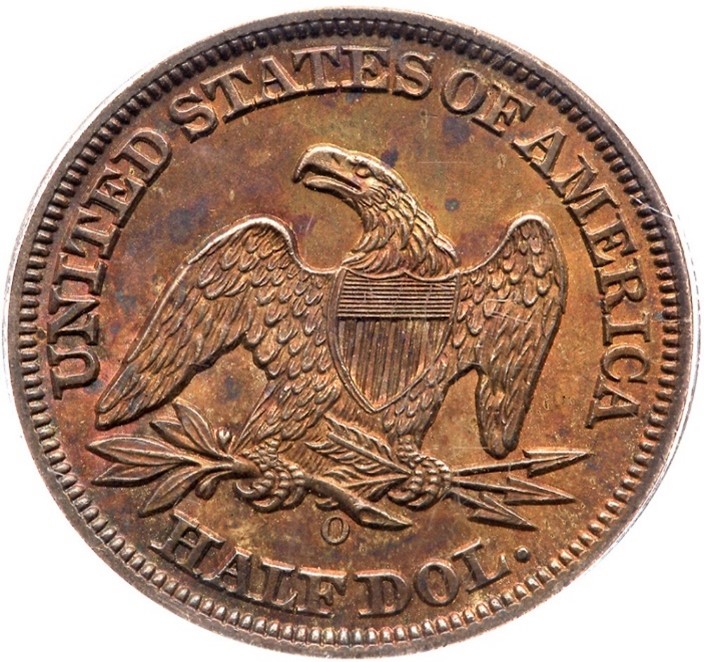
On September 2, 2019, the Goldbergs auctioned a CAC approved, PCGS graded MS-65 1855-O for $6300. On October 14, 2020, Heritage auctioned a PCGS graded MS-65+ 1855-O, with a CAC sticker, for $14,400, a very strong price. On June 4, 2020, Heritage auctioned a PCGS graded MS-66+ 1855-O, with a CAC sticker, for $18,000, a moderate price.
It is important to remember that experts at CAC ignore the plus aspect of plus grades assigned by PCGS or NGC. A coin that was CAC approved while certified as MS-66+ would also have been CAC approved had it been PCGS or NGC graded MS-66 without a plus.
It is especially difficult to estimate an amount that a collector should budget for a gem of the 1854-55 ‘With Arrows’ type. As of Oct. 21, 2021, the CPG-CAC retail price estimates are $7500 for a MS-65 grade 1854-O and $9380 for a MS-65 1855-O. In public and private sales, such halves have brought well above or significantly below these estimates. Additionally, a CAC approved, MS-66 grade coin of this 1854-55 ‘With Arrows’ type would be likely to sell for at least $17,000 late in 2021 or early 2022, possibly much more.
Type #8 – Liberty Seated, Arrows & Rays (1853 only)
Collectors assembling gem type sets almost always seek an 1853 Philadelphia Mint half rather than an 1853 New Orleans Mint half dollar. PCGS and NGC have each graded fifteen 1853 halves as MS-65 or -65+, a total of thirty, though these are not all different coins. CAC has approved six as MS-65. In contrast, for the 1853-O, PCGS reports just one as MS-65 and NGC reports two. CAC has approved one of these three. There are no 1853-O halves certified as grading MS-66 or higher.
It would be sensible for a prospective buyer to figure that a gem 1853 half may cost anywhere between $17,500 and $32,500 in late 2021 or early 2022. Not many have sold recently.
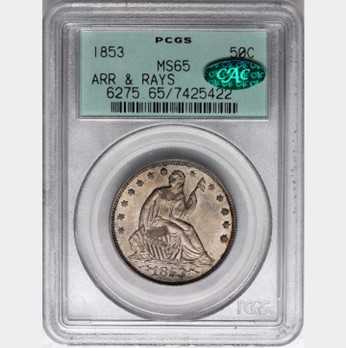
On March 1, 2020, GreatCollections sold a CAC approved MS-65 grade 1853 for $26,400. Back in November 2014, Stack’s-Bowers auctioned a CAC approved MS-65 grade 1853 half dollar for $21,150. I saw it. This was an excellent coin, with neat natural toning and very few imperfections.
Type #7 – Liberty Seated, With Drapery, No Motto (1839-53, 1856-66)
Of the ‘With Drapery – No Motto’ type, just a few really appealing gems are sold publicly each year, an infinitesimal percentage of the total number of that have been certified as grading MS-65 to -68, according to data published by PCGS, NGC and CAC.
PCGS has graded around four hundred halves of this type as gems, and the corresponding NGC census is above three hundred and fifty, as of Oct. 27, 2021. Some coins are counted more than once because they are repeatedly submitted, often after being removed from their respective PCGS or NGC holders.
CAC has approved one hundred and twelve half dollars of this type in the MS-65 range, seventy as MS-66, twelve as MS-67, and one as MS-68. There are some certified MS-65 to -67 coins of this type that have never been submitted to CAC. Furthermore, there are PCGS or NGC graded coins that have been upgraded and hypothetically would have been CAC approved if they were assigned lower grades. I estimate that there are more than two hundred and sixty half dollars of this type that I personally regard or would regard as gems.
Later types of half dollars are much less scarce in gem grades. More than 1500 gem quality Barber halves survive and more than 25,000 gem Walkers. While gem ‘No Motto’ Liberty Seated halves are rare in contrast, it is practical to purchase one in a short time.
On Aug. 20, 2021, Heritage auctioned a PCGS graded MS-65+ 1861, with a CAC sticker, for $5280. The same coin realized $6168.75 in a Heritage auction on March 23, 2014.
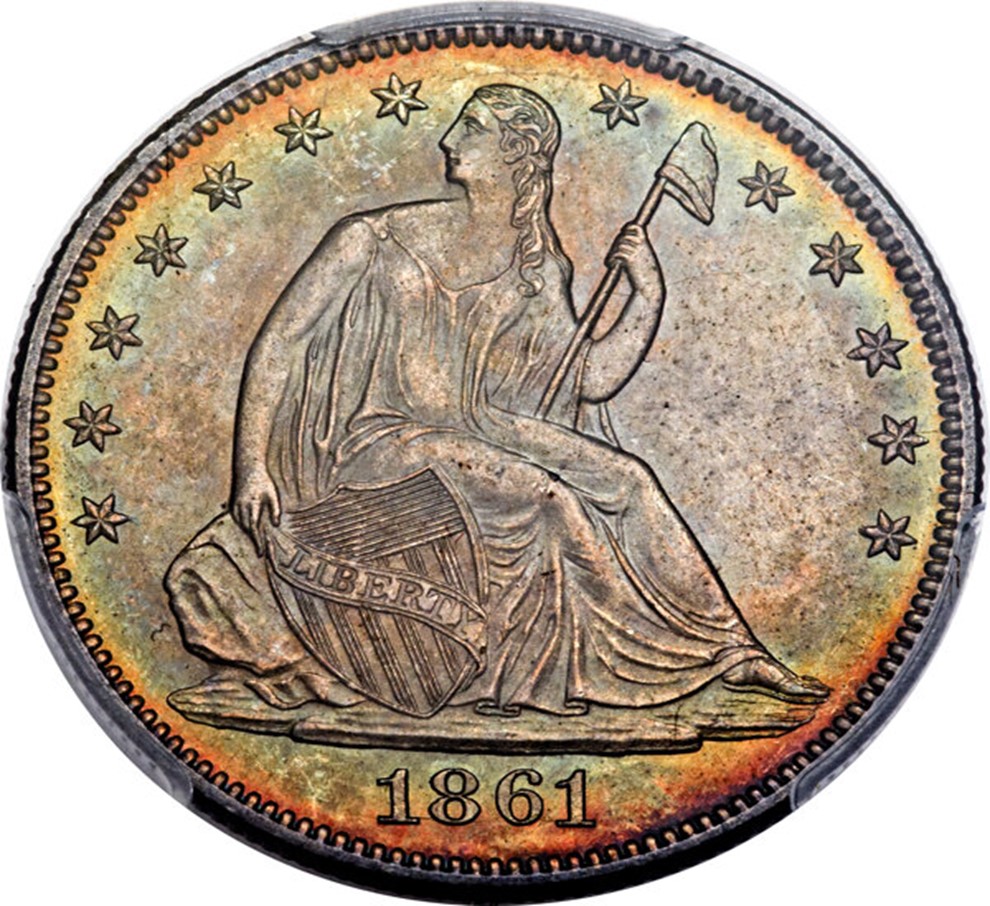
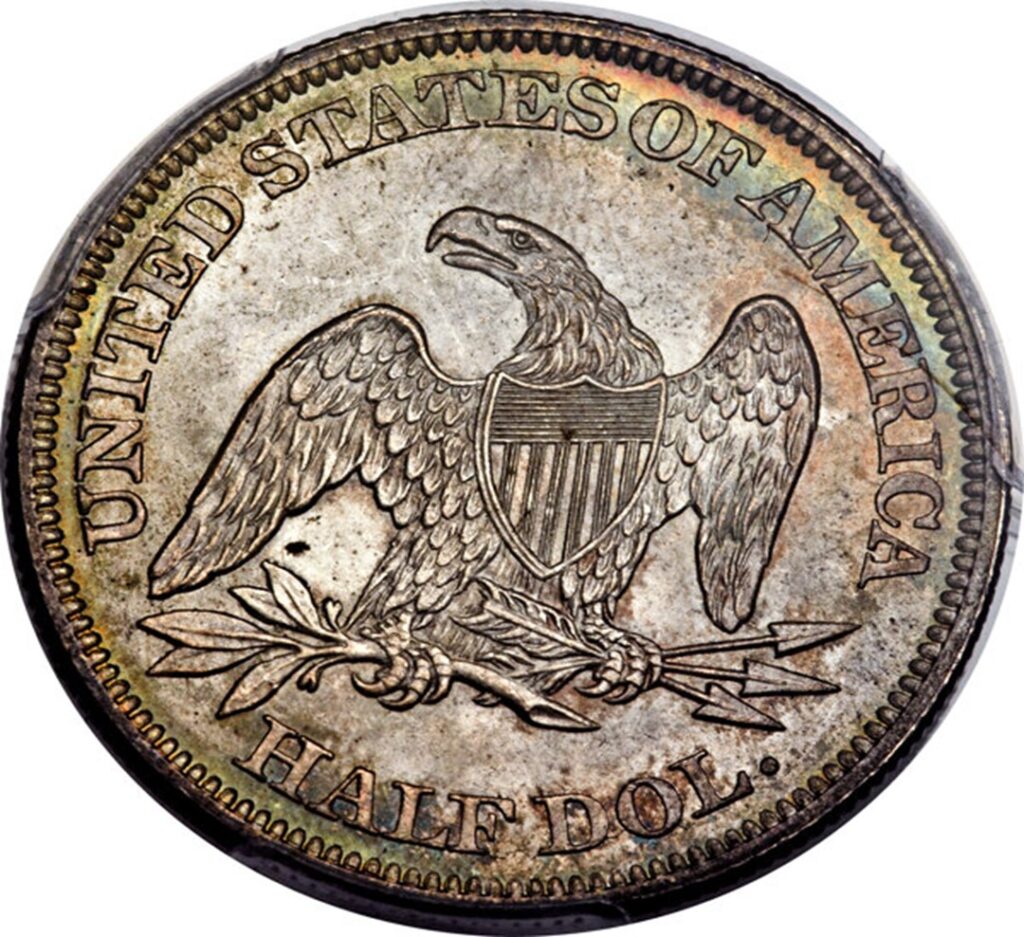
MS-65 grade ‘No Motto’ halves tend to cost a fraction as much as MS-66 grade halves of the same respective dates. On April 25, 2019, Heritage auctioned a PCGS graded MS-66+ 1861, with a CAC sticker for $12,000. A medium retail price for this coin in November 2021 would probably be around $14,000.
An 1861-O from the Gene Gardner Collection was PCGS graded MS-66 and CAC approved. In October 2014, Heritage auctioned it for $18,800. In July 2020, Legend auctioned the same coin in the same holder for $20,562.50. I saw it in 2014. This coin’s toning is attractive. The obverse is really enticing overall. A medium retail price for this coin in 2022 will probably be around $21,500. The CPG-CAC retail estimate for a CAC approved MS-65 (sixty-five) grade 1861-O is $7190.

Show off Your Collection in the CAC Registry!
Have CAC coins of your own? If so, check out the CAC Registry–the free online platform to track your coin inventory, showcase your coins by building public sets, and compete with like-minded collectors!
Type #6 – Liberty Seated, No Drapery, No Motto (1839 only)
In other guides on this site, I have discussed the nature of 1839 ‘No Drapery’ issues. For half dollars, the distinctions between the 1839 ‘No Drapery’ and 1839 ‘With Drapery’ coins are not blatant. While it is generally believed that each type set requires one, collectors will decide for themselves whether one of these is really needed for a type set. There is not a simple correct answer.
CAC has approved zero 1839 ‘No Drapery’ Liberty Seated halves as MS-65 or higher, though has approved five in the MS-64 range. PCGS reports three as MS-65 and two as MS-65+.
On Dec. 17, 2020, Stack’s-Bowers auctioned the Larry Miller Collection 1839 ‘No Drapery’ half, which was PCGS graded MS-65, without a CAC sticker. It has naturally toned to an extent after being rather heavily dipped in the past. It still has a very ‘dipped’ appearance, in my personal opinion. There are a few very noticeable contact marks on the reverse, though a small number for a half dollar size coin. I was more concerned about the cluster of imperfections in the lower right obverse field, in the region near Miss Liberty’s knee and the last star. Again, though, MS-65 grade, half dollar size coins are allowed to have some rather noticeable contact marks and small scratches.
In a commercial or coin business sense, the Larry Miller Collection 1839 ‘No Drapery’ half qualifies for a MS-65 grade. Indeed, most major dealers at a coin convention would probably be accepting of a MS-65 grade. Even so, I am not comfortable with the coin. The $138,000 auction result in that Miller Collection sale was fair. Also, another PCGS graded MS-65 coin of this one-year type was formerly PCGS graded MS-64 and has been in multiple Heritage auctions.
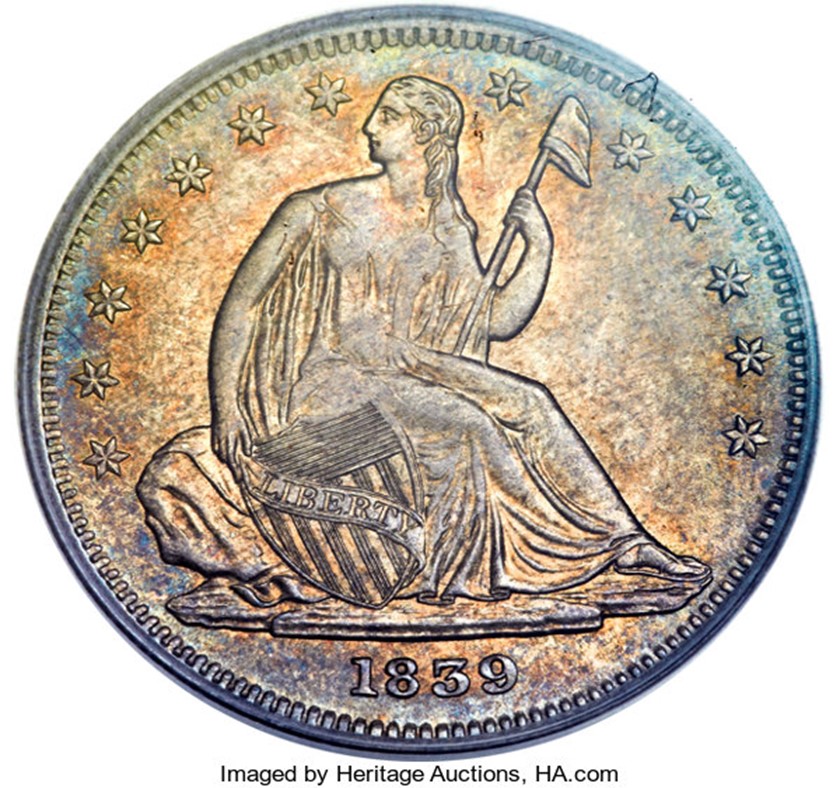
There was an NGC graded MS-67 coin of the 1839 ‘No Drapery’ type, though it is no longer listed in the NGC census. In the past, one MS-67 grade coin was listed by NGC and zero as MS-66. Now, one is listed as graded MS-66 by NGC, with zero higher. There is thus a chance that the NGC graded MS-67 coin was downgraded by NGC to MS-66, though there are other possible explanations for the pertinent change in the NGC census. Additionally, NGC continues to list two as grading MS-65.
Each high quality 1839 ‘No Drapery’ Liberty Seated halves should be extensively analyzed. A collector should definitely consult an expert before acquiring one of the highest certified 1839 ‘No Drapery’ Liberty Seated half dollars. A goal to obtain a CAC approved MS-64 grade coin of this type is a sensible alternative for a collector who is focusing upon gem quality type coins.
Type #5 – Gobrecht Capped Bust, ‘Reeded Edge’ (1836-39)
‘Gobrecht Capped Bust’ is a better name for ‘Reeded Edge’ Capped Bust halves. While it is true that the edges are reeded, the use of this fact as a name, ‘Reeded Edge,’ provides the false impression that this is the only difference or is the main difference between the two design types of Capped Bust halves, Reich (1807-36) and Gobrecht (1836-39). Even if it is imagined that halves of both design types had the same kind of edges, there would still be important differences, especially in artistry and striking characteristics.
There are also differences among Gobrecht ‘Reeded Edge’ halves during the period from 1836 to ’39, regarding silver fineness and reverse design elements. For a gem quality type set, it is best, however, to focus on obtaining one and postpone a decision about obtaining representatives of subtypes. It may not be easy to purchase a true gem Gobrecht Capped Bust half for a reasonable price. I have seen several coins of this type that are certified as MS-65 or MS-66 that I do not personally accept as true gems.
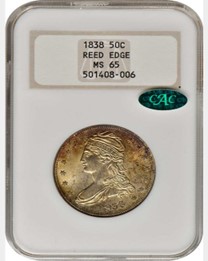
I like the 1838 from the Larry Miller Collection, which Stack’s-Bowers auctioned on Dec. 17, 2020. This CAC approved, NGC graded MS-65 1838 half realized $31,200. It is a realistic possibility, though, that a CAC approved MS-65 grade half of this type may be purchased for less than $31,200 during the next couple of years.
Type #4 – Reich Capped Bust, ‘Lettered Edge’ (1807-36)
It is not difficult to find a CAC approved, MS-65 or MS-66 grade coin of this type. As of Oct. 21, 2021, CAC has approved two hundred and twenty-four Reich Capped Bust halves as MS-65 and ninety-three as MS-66. At least a few are offered each year.
On August 20, 2021, Heritage auctioned a CAC approved, MS-65 grade 1827 ‘Square Base 2’ half for $9300, a weak price in an auction that was strong on average. Collectors who have patience can find good deals in auctions, though I will not draw a conclusion about this specific coin as I have not seen it.
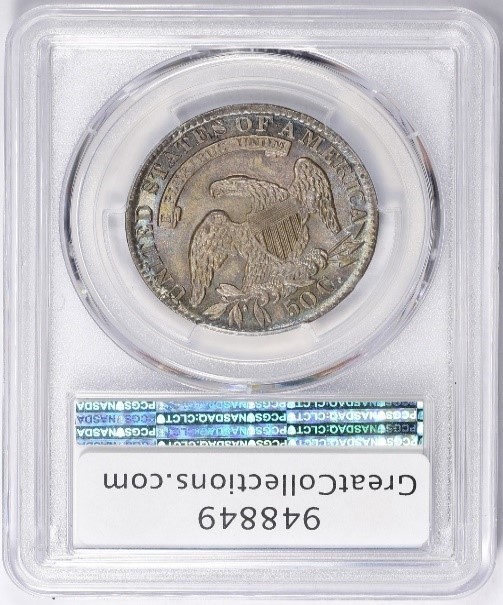
On Feb. 21, 2021, GreatCollections sold a PCGS graded MS-65+ 1834 ‘Large Date, Large Letters’ half dollar, with a CAC sticker, for $8718.75. On Aug. 20, Heritage auctioned a CAC approved, PCGS graded MS-65 1834 ‘Small Date, Small Letters’ half dollar for $8400.
If a retail dealer has a CAC approved MS-65 grade Reich Capped Bust (“Lettered Edge”) half in inventory during late 2021 or early 2002, he will be likely to ask at least $10,000 for it. Better dates may cost much more. Prices realized in auctions and at coin shows are often lower than medium-retail prices for equivalent coins.
Type #3 – Draped Bust, Heraldic Eagle (1801-07)
Draped Bust halves are much scarcer than Reich Capped Bust halves. Of the Draped Bust – Heraldic Eagle type (1801-07), PCGS reports twenty-seven in MS-65 and higher grades, and the NGC census is sixteen. It is unlikely that the combined total of forty-three amounts to even thirty-two different coins and I would not personally grade all of them as high as MS-65. For the type, CAC has approved eleven as MS-65, four as MS-66, and zero above MS-66.
The Pogue Family Collection, 1806 ‘Pointed 6 – No Stem’ half dollar was PCGS graded MS-65 and CAC approved. On May 19, 2015, it realized $129,250.
On January 17, 2021, the firm of David Lawrence sold a CAC approved, PCGS graded MS-65 1806 ‘Pointed 6 – With Stem’ 1806 half for $93,500. If a dealer offers this coin in late 2021 or early 2022, he may very well price it at a level above $105,000.
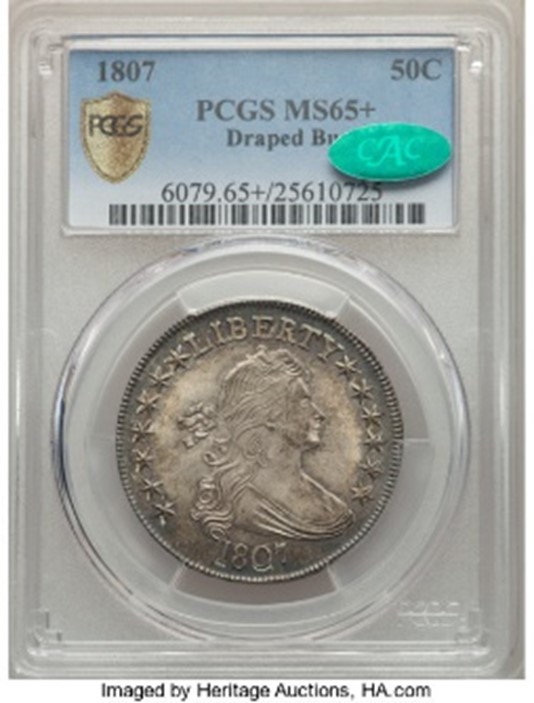
A CAC approved MS-65 grade 1807 Draped Bust half dollar was available at times from 2015 to 2019. In March 2015, while it was NGC graded MS-65, Stack’s-Bowers auctioned this 1807 Draped Bust half for $129,250. In April 2016, after being PCGS graded as MS-65+ and CAC approved, Heritage auctioned it for $141,000. Moreover, Heritage auctioned this same 1807 half again in April 2019 for $105,000. A fair retail price for it in late 2021 might be around $125,000.

Type #2 – Draped Bust, Small Eagle (1796-97)
This is the rarest design type of U.S. silver coins, unless Gobrecht silver dollars (1836-39) are considered to be a design type. Gem Uncirculated 1796 and 1797 halves are prohibitively rare. A collector should not assume that he will be able to buy a gem for a fair price, or for any price, in the near future.
CAC has approved just two gems of this (1796-97) design type, the Rogers-Foxfire-Pogue-Tyrant 1797 as MS-66 and the Norweb 1797 as MS-65. I have written in depth about both coins in multiple publications.
The Rogers-Foxfire-Pogue 1797 was auctioned by Stack’s-Bowers, in association with Sotheby’s, for $1,527,500 in May 2015 and by Stack’s-Bowers again for $1,680,000 on March 25, 2021. It is now ensconced in “The Tyrant Collection.”
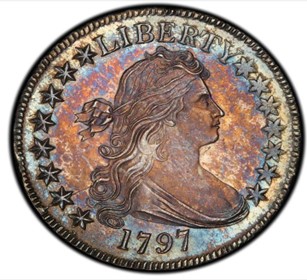
The Norweb 1797 was NGC graded MS-66 before March 2004 and PCGS graded as MS-65+ in 2010. In March 2004, ANR auctioned it for $966,000. In July 2008, the firm that resulted from the Stack’s-ANR merger auctioned the Norweb 1797 half for $1,380,000. In August 2014, Heritage auctioned this same coin for $1,292,500.
The Rogers-Whitney-Pogue 1796 half dollar has been graded MS-66 by both PCGS and NGC, though is not CAC approved. In my personal opinion, not that of anyone at CAC or at any grading service, the Rogers-Whitney 1796 half grades in the low end of the MS-65 range and is a true gem. In other words, the Rogers-Whitney-Pogue 1796 is a terrific coin; I just would not grade it as MS-66 or even as close to MS-66.
On May 19, 2015, Stack’s-Bowers, in association with Sotheby’s, auctioned the Rogers-Whitney-Pogue 1796 for $822,500. In my view, a fair collector price for it in late 2021 would be around $925,000.
As for MS-63 to -64 grade 1796 and 1797 half dollars, please see my corresponding discussion regarding a type set of Choice Uncirculated, classic U.S. half dollars. A goal of obtaining a MS-63 to -64 grade half of this type may be more realistic than the idea of obtaining a gem.
Type #1 – Flowing Hair (1794-95)
There is no point in discussing gem quality 1794 halves, as zero have survived. CAC has approved three 1795 halves as MS-65, though I am not certain that these amount to three different coins. PCGS lists two 1795 halves as MS-65 and one as MS-65+. The NGC census also lists three as MS-65. Of these six, it is very unclear as to how many are different coins.
Certified MS-65 grade 1795 half dollars are rarely seen or heard about. The subject of Gem Uncirculated, Flowing Hair half dollars is a little mysterious.
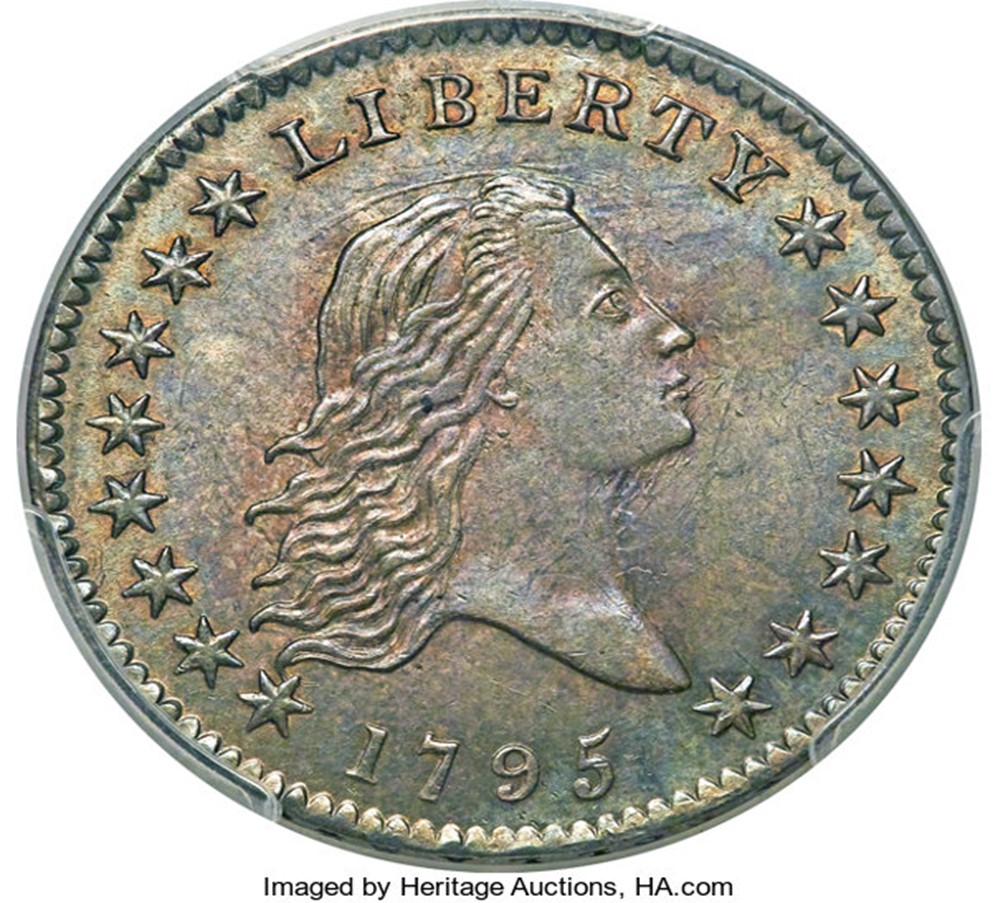
The only true gem 1795 half dollar that comes to my mind at the moment is the Pogue-Simpson 1795 ‘Two Leaves’ variety half, which is a fabulous coin. I feel fortunate to have examined it in 2015 and again in 2021.
When it was auctioned by Stack’s-Bowers, in association with Sotheby’s, on May 19, 2015, it was PCGS graded MS-65 and had been CAC approved. Later, while owned by Bob Simpson, it was upgraded by PCGS to 65+. In May 2015, the Pogue-Simpson 1795 realized $411,250. In February 2021, it realized $552,000.
Collectors who are willing and able to buy gem quality 1795 half dollars should consider the possibility that these may not be available in the near future. Someone building a gem type set may have to settle for a MS-64 or MS-63 grade 1795 half.
It may be a good idea for a collector who desires a gem quality type set of half dollars to focus on 19th century types before even thinking about 18th century types. While an entirely gem set comprising all thirteen types of classic U.S. half dollars may be impossible to assemble in the near future, if ever, a type set with ten gems and three Choice Uncirculated coins would be a landmark achievement!
Images are copyrighted by Heritage Auctions, Goldberg Auctions, Stack’s Bowers Galleries, and Great Collections.
Copyright © 2021 Greg Reynolds
About the Author
Greg is a professional numismatist and researcher, having written more than 775 articles published in ten different publications relating to coins, patterns, and medals. He has won awards for analyses, interpretation of rarity, historical research, and critiques. In 2002 and again in 2023, Reynolds was the sole winner of the Numismatic Literary Guild (NLG) award for “Best All-Around Portfolio”.
Greg has carefully examined thousands of truly rare and conditionally rare classic U.S. coins, including a majority of the most famous rarities. He is also an expert in British coins. He is available for private consultations.
Email: Insightful10@gmail.com
